Blimp Squadron 14

First transatlantic crossing by non-rigid airships
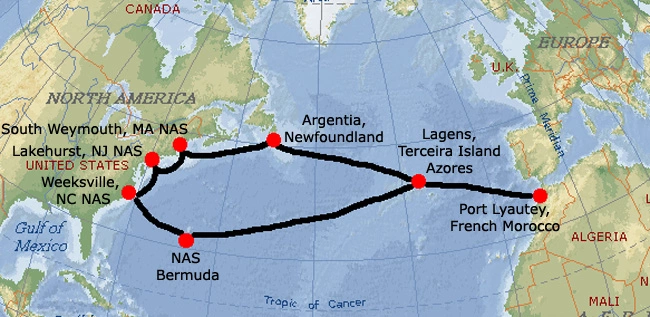
From United States Naval Air Operations in WWII:
JUNE 1, 1944 - Airships of ZP‑14, assigned to antisubmarine operations around Gibraltar, completed the first crossing of the Atlantic by non-rigid airships. The flight began 29 May from South Weymouth, Mass., and ended at Port Lyautey, French Morocco, covering a distance of 3,145 nautical miles in 58 hours. Including time for stopovers at Argentia and the Azores, the airships moved their area of operations across the Atlantic in 80 hours.
Historical background
Airship Squadron 14 was established on June 2, 1942 at Weeksville, North Carolina NAS but operated from the coast guard station at Elizabeth City, NC until the blimp landing facilities were established at Weeksville on June 8, 1942. the squadron was also known as ZP‑14, Blimp Squadron 14, Blimpron‑14, Blimp Squadron Fourteen, or The Africa Squadron.
To assist with anti-submarine warfare (ASW) around the Straits of Gibraltar, the Navy decided to send six blimps overseas in 1944. PBY‑5A Catalina aircraft from VP‑63 (Patrol Bombing Squadron 63 or VPB-63), THE MAD CATS, had been searching for and sinking German U-boats since early 1944. However, because of the low altitude required (75-100 feet) for effective magnetic anomaly detection (MAD), the Catalinas could not search safely at night. The slow-flying blimps were determined to be the perfect solution for night-time MAD patrols.
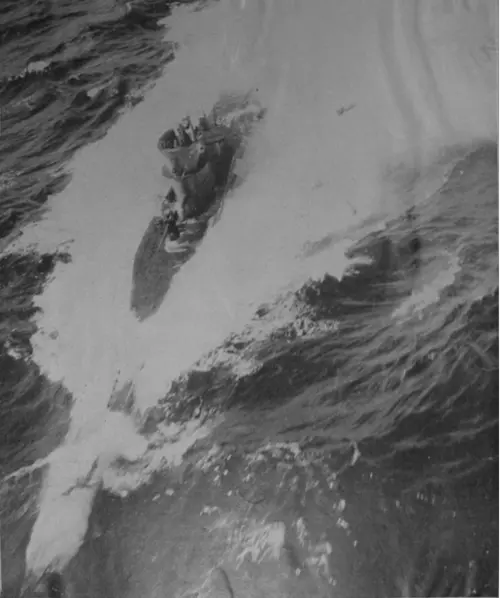
Transatlantic flights
An advanced detachment of ZP-14 maintenance crews (hedrons) left Norfolk, VA aboard the USS Rehoboth (AVP-50) on May 17, 1944 to set-up ferry facilities in the Azores and a permanent lighter-than-air (LTA) base at Port Lyautey, French Morocco. To avoid putting all their eggs in one basket, the Navy sent the blimps across in pairs using different crews for each leg of the flight. The flight crews for the second and third legs took Navy R5D transports from the States to Newfoundland and the Azores, respectively.
The first six blimps (K‑ships) traveled the northern route (see map above). Blimps K‑123 and K‑130 were the first to go. They left South Weymouth Naval Air Station (NAS) in Massachusetts about 8:00 PM EDT on May 28, 1944 and flew ~16 hours to Argentia, Newfoundland. The next day, fresh crews flew the blimps ~22 hours to Lagens (Lajes) Field on Terceira Island in the Azores. The final crews including ZP-14 Squadron Commander Emmett J. Sullivan, who piloted K‑130, flew about 20 hours from the Azores to Craw Field at Port Lyautey, French Morocco (now Kenitra, Morocco).
The entire trip covered 3,145 nautical miles and took 80 hours with 58 hours of flying time at an elvation of about 500 feet. The second pair of blimps, K‑109 and K‑134, arrived in Port Lyautey on June 15, 1944 and the last pair, K‑101 and K‑112, arrived on July 1, 1944. See the flight details for the northern route.
Nearly a year later, on April 28, 1945, K‑89 and K‑114 left Weeksville NAS in North Carolina and flew the southern route (see map above) to NAS Bermuda, the Azores, and Port Lyautey, arriving on May 1, 1945. The southern route covered 3,532 nautical miles in just 77 hours with 62 hours of flying time. The eight K‑ships (K‑123, K‑130, K‑109, K‑134, K‑101, K‑112, K‑89, & K‑114) were the only blimps sent across the Atlantic during WWII.
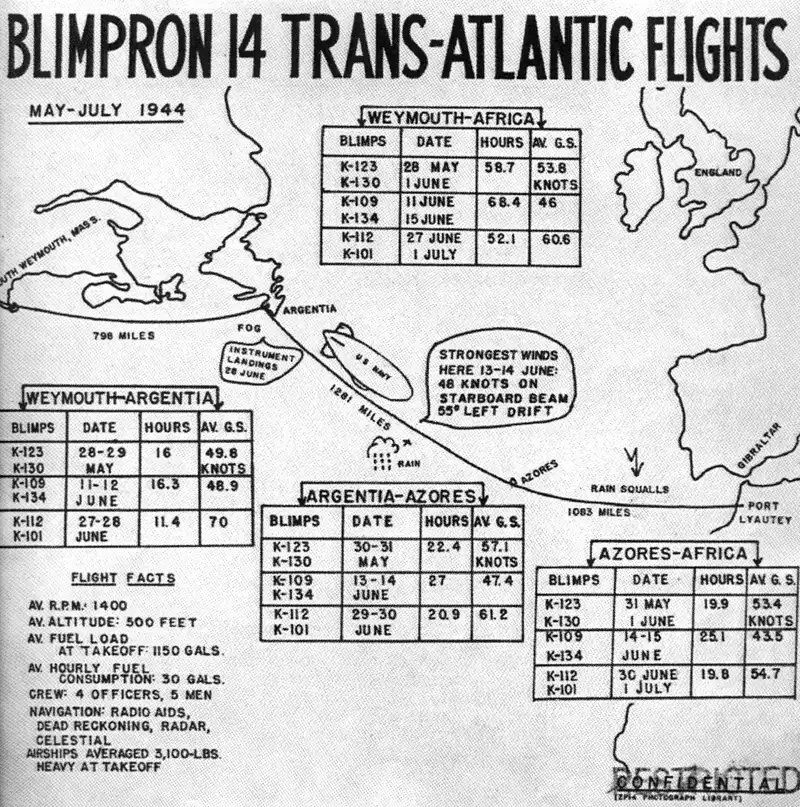
Port Lyautey
The blimps of ZP-14 and the PBYs of VPB-63 used Port Lyautey as their base. PBYs of USN patrol squadron VPB-63 had been conducting anti-submarine warfare (ASW) using magnetic anomaly detection (MAD) in the Atlantic and especially around the Strait of Gibraltar. However, the low altitude (less than 100 feet) required for MAD was dangerous for the PBYs and B-24s at night or in heavy fog.

According to my uncle's notes, it was rumored in Blimp Squadron 14 that the use of blimps to conduct nighttime MAD operations at Gibraltar was Winston Churchill's idea. Anyway, the blimps made their record-setting transatlantic flights and along with the PBYs, conducted 24/7 MAD surveillance around the Strait of Gibraltar from June of 1944 onward. It's not surprising that very few MAD detections were made and no U-boats were sunk during this period because the Germans had decided to stop sending U-boats through the "magnetic fence" at Gibraltar about the same time the first two blimps arrived there on June 1, 1944. The last U-boat sinking in the region was on May 15, 1944 after two Port Lyautey-based VPB-63 Madcat PBYs piloted by Matthias Vopatek and Hubert Worrel tracked the U-731 through the Gibraltar fence and damaged it with bombs. The sub was eventually sunk by depth charges from HMS Blackfly and HMS Kilmarnock.
This website presents some of the interesting history of Blimp Squadron 14 and its Mediterranean operations as revealed in: 1) the five-volume photographic history of Blimpron 14 Overseas prepared by the squadron photographic officer R. C. Kline , 2) the official history of ZP‑14 from the Naval Historical Center at the Navy Yard in Washington, D. C., and 3) the personal notes, logbooks, stories, photographs, etc. from various squadron personnel.
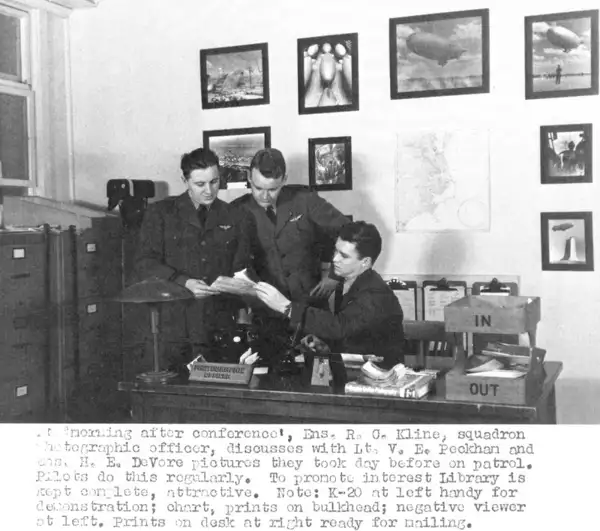
The first transatlantic flights and Mediterranean operations of Blimp Squadron 14 were considered significant enough achievements that my article about them was selected for the Spring 2011 Issue of Naval Aviation News to help commemorate the Centennial of Naval Aviation (1911-2011).
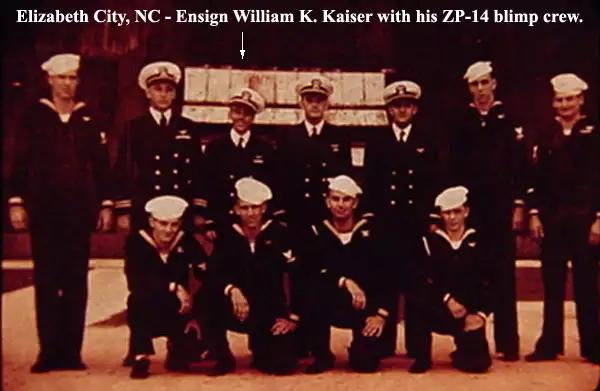
Also pictured are Ensign Warren H. Ireland, standing fourth from left, and Aviation Radioman Second Class Paul Galbreath, standing on the far right. Ensign Kaiser was a co-pilot on airship K‑123, the first blimp to take-off from the Azores and the second blimp to land at Port Lyautey on June 1, 1944, completing the final leg of the first transatlantic crossing by non-rigid airships.
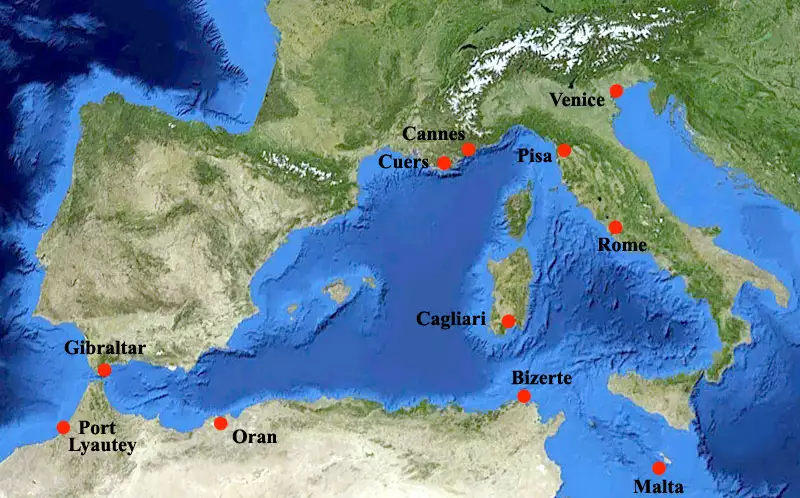
Links
The Naval Airship Association, Inc.
History of Blimp Squadron Fourteen Overseas
Evaluation of Geomagnetic Activity in the MAD Frequency Band
Contact:: don{dot}kaiser{at}gmail{dot}com
